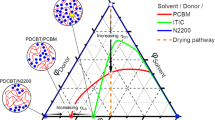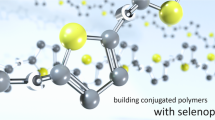Abstract
The specific optical absorption of an organic semiconductor is critical to the performance of organic optoelectronic devices. For example, higher light-harvesting efficiency can lead to higher photocurrent in solar cells that are limited by sub-optimal electrical transport. Here, we compare over 40 conjugated polymers, and find that many different chemical structures share an apparent maximum in their extinction coefficients. However, a diketopyrrolopyrrole-thienothiophene copolymer shows remarkably high optical absorption at relatively low photon energies. By investigating its backbone structure and conformation with measurements and quantum chemical calculations, we find that the high optical absorption can be explained by the high persistence length of the polymer. Accordingly, we demonstrate high absorption in other polymers with high theoretical persistence length. Visible light harvesting may be enhanced in other conjugated polymers through judicious design of the structure.
This is a preview of subscription content, access via your institution
Access options
Subscribe to this journal
Receive 12 print issues and online access
$259.00 per year
only $21.58 per issue
Buy this article
- Purchase on Springer Link
- Instant access to full article PDF
Prices may be subject to local taxes which are calculated during checkout






Similar content being viewed by others
References
Pope, M., Swenberg, C. E. & Pope, M. Electronic Processes in Organic Crystals and Polymers 2nd edn (Oxford Univ. Press, 1999).
Köhler, A. & Bässler, H. Electronic Processes in Organic Semiconductors: An Introduction (John Wiley, 2015).
Spano, F. C. & Silva, C. H- and J-aggregate behavior in polymeric semiconductors. Annu. Rev. Phys. Chem. 65, 477–500 (2014).
Tian, B., Zerbi, G., Schenk, R. & Mullen, K. Optical-spectra and structure of oligomeric models of polyparaphenylenevinylene. J. Chem. Phys. 95, 3191–3197 (1991).
Puschnig, P. et al. Electronic, optical, and structural properties of oligophenylene molecular crystals under high pressure: an ab initio investigation. Phys. Rev. B 67, 235321 (2003).
Prest, W. M. & Luca, D. J. Origin of the optical anisotropy of solvent cast polymeric films. J. Appl. Phys. 50, 6067–6071 (1979).
Prest, W. M. & Luca, D. J. The alignment of polymers during the solvent-coating process. J. Appl. Phys. 51, 5170–5174 (1980).
Koynov, K. et al. Molecular weight dependence of chain orientation and optical constants of thin films of the conjugated polymer MEH-PPV. Macromolecules 39, 8692–8698 (2006).
Clark, J., Chang, J. F., Spano, F. C., Friend, R. H. & Silva, C. Determining exciton bandwidth and film microstructure in polythiophene films using linear absorption spectroscopy. Appl. Phys. Lett. 94, 163306 (2009).
Hestand, N. J. et al. Confirmation of the origins of panchromatic spectra in squaraine thin films targeted for organic photovoltaic devices. J. Phys. Chem. C 119, 18964–18974 (2015).
Yao, K., Xu, Y. X., Li, F., Wang, X. F. & Zhou, L. A simple and universal method to increase light absorption in ternary blend polymer solar cells based on ladder-type polymers. Adv. Opt. Mater. 3, 321–327 (2015).
Sjoqvist, J., Linares, M., Lindgren, M. & Norman, P. Molecular dynamics effects on luminescence properties of oligothiophene derivatives: a molecular mechanics-response theory study based on the CHARMM force field and density functional theory. Phys. Chem. Chem. Phys. 13, 17532–17542 (2011).
Hedstrom, S., Henriksson, P., Wang, E., Andersson, M. R. & Persson, P. Light-harvesting capabilities of low band gap donor–acceptor polymers. Phys. Chem. Chem. Phys. 16, 24853–24865 (2014).
Grimm, B., Risko, C., Azoulay, J. D., Bredas, J. L. & Bazan, G. C. Structural dependence of the optical properties of narrow bandgap semiconductors with orthogonal donor–acceptor geometries. Chem. Sci. 4, 1807–1819 (2013).
Mishra, A. et al. A-D-A-type S, N-heteropentacenes: next-generation molecular donor materials for efficient vacuum-processed organic solar cells. Adv. Mater. 26, 7217–7223 (2014).
Xu, Y. X. et al. Improved charge transport and absorption coefficient in indacenodithieno[3,2-b]thiophene-based ladder-type polymer leading to highly efficient polymer solar cells. Adv. Mater. 24, 6356–6361 (2012).
Rau, U. Reciprocity relation between photovoltaic quantum efficiency and electroluminescent emission of solar cells. Phys. Rev. B 76, 085303 (2007).
Campoy-Quiles, M., Alonso, M. I., Bradley, D. D. C. & Richter, L. J. Advanced ellipsometric characterization of conjugated polymer films. Adv. Funct. Mater. 24, 2116–2134 (2014).
Bronstein, H. et al. Thieno[3,2-b]thiophene-diketopyrrolopyrrole-containing polymers for high-performance organic field-effect transistors and organic photovoltaic devices. J. Am. Chem. Soc. 133, 3272–3275 (2011).
Wood, S. et al. Natures of optical absorption transitions and excitation energy dependent photostability of diketopyrrolopyrrole (DPP)-based photovoltaic copolymers. Energy Env. Sci. 8, 3222–3232 (2015).
Meager, I. et al. Photocurrent enhancement from diketopyrrolopyrrole polymer solar cells through alkyl-chain branching point manipulation. J. Am. Chem. Soc. 135, 11537–11540 (2013).
Meager, I. et al. Power conversion efficiency enhancement in diketopyrrolopyrrole based solar cells through polymer fractionation. J. Mater. Chem. C 2, 8593–8598 (2014).
Kline, R. J. et al. Dependence of regioregular poly(3-hexylthiophene) film morphology and field-effect mobility on molecular weight. Macromolecules 38, 3312–3319 (2005).
Chang, J.-F. et al. Molecular-weight dependence of interchain polaron delocalization and exciton bandwidth in high-mobility conjugated polymers. Phys. Rev. B 74, 115318 (2006).
Fox, M. Optical Properties of Solids (Oxford Univ. Press, 2001).
Koch, F. P. Synthesis and Physical Chemistry of a ‘Monomer-up Approach’ PhD thesis, ETH Zurich (2013).
Schumacher, S. et al. Effect of exciton self-trapping and molecular conformation on photophysical properties of oligofluorenes. J. Chem. Phys. 131, 154906 (2009).
Li, W. et al. One-step synthesis of precursor oligomers for organic photovoltaics—a comparative study between polymers and small molecules. ACS Appl. Mater. Interfaces 7, 27106–27114 (2015).
van Faassen, M., de Boeij, P. L., van Leeuwen, R., Berger, J. A. & Snijders, J. G. Ultranonlocality in time-dependent current-density-functional theory: application to conjugated polymers. Phys. Rev. Lett. 88, 186401 (2002).
Albuquerque, R. Q., Hofmann, C. C., Kohler, J. & Kohler, A. Diffusion-limited energy transfer in blends of oligofluorenes with an anthracene derivative. J. Phys. Chem. B 115, 8063–8070 (2011).
Rossi, G., Chance, R. R. & Silbey, R. Conformational disorder in conjugated polymers. J. Chem. Phys. 90, 7594–7601 (1989).
Soos, Z. G. & Schweizer, K. S. Absorption-spectrum of flexible conjugated polymers—the weak-disorder limit. Chem. Phys. Lett. 139, 196–200 (1987).
Flory, P. J. Statistical Mechanics of Chain Molecules (Interscience Publishers, 1969).
Jackson, N. E. et al. Conformational order in aggregates of conjugated polymers. J. Am. Chem. Soc. 137, 6254–6262 (2015).
Chung, W. J., Shibaguchi, H., Terao, K., Fujiki, M. & Naito, M. Evaluation of global conformation of polydialkylsilane using correlation between persistence length and excitonic absorption. Macromolecules 44, 6568–6573 (2011).
Vanhee, S. et al. Synthesis and characterization of rigid rod poly(p-phenylenes). Macromolecules 29, 5136–5142 (1996).
Bronstein, H. et al. Indacenodithiophene-co-benzothiadiazole copolymers for high performance solar cells or transistors via alkyl chain optimization. Macromolecules 44, 6649–6652 (2011).
Venkateshvaran, D. et al. Approaching disorder-free transport in high-mobility conjugated polymers. Nature 515, 384–388 (2014).
Marcus, M., Tozer, O. R. & Barford, W. Theory of optical transitions in conjugated polymers. II. Real systems. J. Chem. Phys. 141, 164102 (2014).
Hestand, N. J. & Spano, F. C. The effect of chain bending on the photophysical properties of conjugated polymers. J. Phys. Chem. B 118, 8352–8363 (2014).
Hayes, S. C. & Silva, C. Analysis of the excited-state absorption spectral bandshape of oligofluorenes. J. Chem. Phys. 132, 214510 (2010).
Myers, A. B. & Mathies, R. A. in Biological applications of Raman Spectroscopy: Resonance Raman Spectra of Polyenes and Aromatics Vol. 2 (ed. Spiro, T. G.) 1–58 (1987).
van Franeker, J. J., Turbiez, M., Li, W. W., Wienk, M. M. & Janssen, R. A. J. A real-time study of the benefits of co-solvents in polymer solar cell processing. Nature Commun. 6, 6229 (2015).
Campoy-Quiles, M., Nelson, J., Bradley, D. & Etchegoin, P. Dimensionality of electronic excitations in organic semiconductors: a dielectric function approach. Phys. Rev. B 76, 235206 (2007).
Acknowledgements
M.S.V. and S.F. are grateful to the Engineering and Physical Sciences Research Council (EPSRC) for a doctoral training award and a CDT studentship (EP/G037515/1), respectively. G.P. and S.C.H. acknowledge the University of Cyprus for funding through the internal grant ‘ORGANIC’. B.D., A.R.G. and M.C.-Q. acknowledge financial support from the Ministerio de Economía y Competitividad of Spain through projects CSD2010–00044 (Consolider NANOTHERM), SEV-2015–0496 and MAT2012–37776 and the European Research Council through project ERC CoG648901. I.Meager., R.S.A. and I.McCulloch acknowledge support from the European Commission FP7 Project ArtESun (604397). J.N. is grateful to the Royal Society for a Wolfson Merit Award, and acknowledges financial support from EPSRC grants EP/K030671/1, EP/K029843/1 and EP/J017361/1. The authors thank I. Alonso for performing supplementary ellipsometric measurements; we thank T. Kirchartz, J. Moore Frost, C. Müller, I. Alonso and A. Myers for helpful discussions.
Author information
Authors and Affiliations
Contributions
M.S.V. coordinated the experimental work, made films, performed solution ultraviolet–visible measurements, and did electrical characterization. S.F. did the quantum chemical calculations. I.M. and H.B. made the DPP-TT-T and IDTBT polymers, respectively, under the supervision of I.McCulloch. G.P. and S.C.H. performed the RR spectroscopy measurements and subsequent analysis. B.D., A.R.G. and M.C.-Q. did the ellipsometry measurements. R.S.A. made the devices. J.N. supervised the work.
Corresponding authors
Ethics declarations
Competing interests
The authors declare no competing financial interests.
Supplementary information
Supplementary Information
Supplementary Information (PDF 6529 kb)
Rights and permissions
About this article
Cite this article
Vezie, M., Few, S., Meager, I. et al. Exploring the origin of high optical absorption in conjugated polymers. Nature Mater 15, 746–753 (2016). https://doi.org/10.1038/nmat4645
Received:
Accepted:
Published:
Issue Date:
DOI: https://doi.org/10.1038/nmat4645
This article is cited by
-
Metallopolymer strategy to explore hypoxic active narrow-bandgap photosensitizers for effective cancer photodynamic therapy
Nature Communications (2024)
-
Heterogeneous Oriented Structure model of thermoelectric transport in conducting polymers
Scientific Reports (2023)
-
Key molecular perspectives for high stability in organic photovoltaics
Nature Reviews Materials (2023)
-
Hierarchical porous photosensitizers with efficient photooxidation
Nature Communications (2023)
-
Surface enrichment structures in a binary polymer system with different stiffnesses confined in slits
Colloid and Polymer Science (2023)



